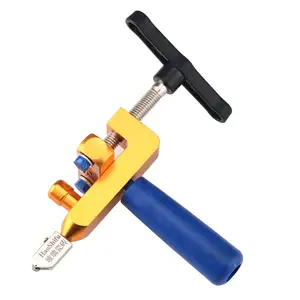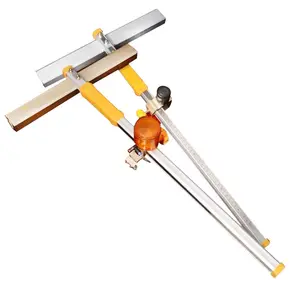Introduction
Embarking on a glass cutting project requires not only skill and practice but also the right tools. The art of glass cutting involves scoring the glass and breaking it along the score, a process that demands precision and understanding. The tools you choose can significantly impact the quality of your cuts, making the selection process crucial. This guide will delve into the world of glass cutting, exploring different types of tools, their uses, and how to choose the right one for your project. We'll also discuss safety measures and precautions to ensure a successful and safe glass cutting experience.
Understanding Glass Cutting
Glass cutting is a skill that requires practice and the right tools. The process involves scoring the glass with a cutter and then breaking it along the score. The pressure applied during scoring is crucial, and it varies depending on the thickness of the glass. For beginners, it's recommended to practice on scrap glass before moving on to actual projects. The most important thing to learn glass cutting is practice, practice, and more practice!
Why the Right Tools Matter
The right glass cutting tools are crucial for achieving clean, precise cuts. Tools like the wheel cutter, which has been a standard due to their effectiveness. The cutting wheel, often made of hardened steel or tungsten carbide, creates a score in the glass, guiding the break. The hone angle of the wheel is critical, with sharper angles designed for thicker glass. Lubrication, often with oil, is also essential to prevent overheating and ensure smooth scoring. The wheel's diameter also impacts the cutting process, with different sizes suited for various applications and glass thicknesses.
Types of Glass Cutting Tools
Glass cutting is a crucial skill in kilnforming, and the right tools can significantly enhance the precision and efficiency of the process. Some of the essential glass cutting tools include handheld cutters, circle cutters, breaking pliers, grozing pliers, and nippers. There are also cutting systems and various cutting accessories available. These tools have been extensively used and tested by artists and instructors, ensuring their quality and effectiveness.
Manual Glass Cutters
Manual glass cutting is a fundamental step in glass processing, involving scoring the glass surface to release tensions, leading to a controlled break. The precision of the break depends on the use of suitable tools. These tools form part of one of the world's largest selections of products for cutting and breaking flat glass.
Glass Cutting Machines
High-performance CNC glass cutting machines are a crucial tool in the glass industry. These machines ensure well-cut glass, making breakout easier and minimizing chips. They are designed for high speed, tight tolerance, and robustness, serving various markets including automotive and appliance. Depending on the machine, features may include full-width belts for conveyance and support, a vacuum system for part holding, and an automatic breaking device. They also offer options like laser marking and label print/apply solutions. The range of machines caters to different project sizes, promising accuracy and dependability.
Glass Cutting Accessories
Quality tools are essential for smooth, accurate glass cutting. Among these tools, you'll find handheld cutters, circle cutters, breaking pliers, grozing pliers, and nippers. Cutting systems and accessories also play a crucial role. These tools have been extensively used and tested by artists and instructors, ensuring their effectiveness and reliability in glass cutting.
Choosing the Right Tool for Your Project
Choosing the right glass cutting tool is crucial for the success of your project. Different styles of cutters offer varied grips and control. Your choice depends on your comfort and physical makeup. For instance, some cutters are favored by many for their comfortable grip. It's important to try different cutters to find the one that suits you best, as the right cutter can significantly improve the consistency and accuracy of your cuts.
Consider Your Project Needs
When considering your project needs for glass cutting, it's crucial to prepare the area and the glass itself. Choose a large, flat surface and protect it with a soft mat. Clean the glass with a glass cleaner and a cutting rag, focusing on the areas where you plan to cut. Different types of glass, such as acrylic, polycarbonate, and traditional glass, are suitable for various indoor or outdoor projects. Remember to measure and mark the glass accurately before cutting. Lubricate the material with cutting oil for a neater cut.
Evaluate Your Skill Level
Cutting glass can be a straightforward task with the right tools, the right thickness of glass, and a steady hand. However, the difficulty level can increase depending on the type of glass, its thickness, and the size of the glass pane. It's important to note that glass usually only allows for one attempt. If it shatters, breaks, or gets chipped or scratched, it's often permanently damaged and unusable. Therefore, if you're considering cutting your own glass, it's crucial to evaluate your skill level and decide whether it's a realistic option or if professional help is needed.
Budget and Quality Considerations
When considering your budget and quality for glass cutting tools, Alibaba offers a wide range of options. Prices range from as low as $0 - $10, extending up to $2000 - $3000, catering to various budget constraints. These tools, along with accessories, provide quality and value for your investment. Always remember, the right tool can make a significant difference in the outcome of your project.
Safety Measures and Precautions
Safety is paramount when handling glass cutting tools. Mishandling can lead to severe injuries, including punctures, cuts, and even amputations. Proper handling techniques are crucial, especially in workplaces where large volumes of glass are handled daily. This includes safe handling of vertical glass sheet storage racks, use of personal protective equipment, and proper loading/unloading of glass. Additionally, it's important to ensure hearing protection in areas where glass is cut and protection against inhalation of silica dust in glass cutting operations.
Proper Handling of Tools
Proper handling of tools is crucial when cutting glass. Begin by placing the cutter on the surface of the material at the mark. Apply pressure while keeping the cutter slightly angled and tilted towards you. Slowly move the cutter across the surface in a slow and controlled motion until you’ve reached the end and have finished scoring. Repeat as needed. To break the glass, use the head of the glass cutter to elevate the glass. Firmly hold the material on both sides of the cut, apply pressure and break it apart as if you were opening the spine of a book.
Protective Gear
Working in the glass industry requires high-quality protective gear. Some garments are up to 30% lighter than competitive products, offering high levels of cut protection with unmatched comfort and breathability. They also offer a line of gloves that deliver a combination of high cut resistance, dexterity, and glass-industry-approved coatings. These innovations in personal protective equipment (PPE) are changing the game, offering the highest levels of protection with unmatched comfort and range of motion, ensuring safety in the glass cutting industry.
Conclusion
In conclusion, glass cutting is a delicate art that requires the right tools, a good understanding of the process, and a keen eye for safety. The choice of tools, from manual cutters to high-performance CNC machines, depends on your project needs, skill level, and budget. It's essential to consider the type of glass, its thickness, and the size of the pane before starting. Safety measures, including proper handling of tools and protective gear, are paramount to prevent injuries. Whether you're a beginner or a seasoned professional, this guide aims to provide you with the knowledge to choose the right glass cutting tools for your project, ensuring precision, efficiency, and safety.

































 浙公网安备 33010002000092号
浙公网安备 33010002000092号 浙B2-20120091-4
浙B2-20120091-4